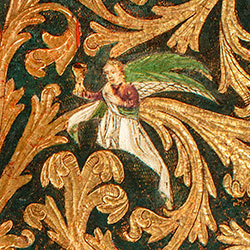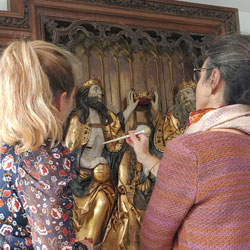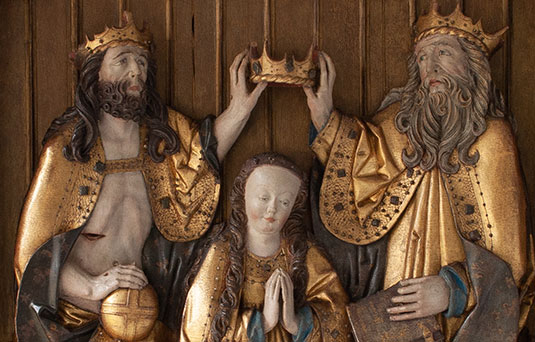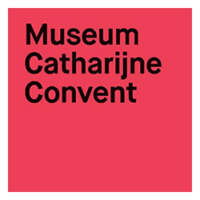
Study Day

‘The Application of Gold
in Medieval Art in Dutch collections’
Monday 2 October 2023 – 9.45 a.m. – 6.00 p.m.
op Castle Huis Bergh, ‘s-Heerenberg
Two magnificent works of art from Dutch collections, an altarpiece representing The Coronation of the Virgin (Germany, 1510-1530) in Castle Huis-Bergh (‘s-Heerenberg) and a Crucifixion attributed to the Master of Lindau (Germany, 1430) in Museum Catharijneconvent (Utrecht) have been recently restored. To conclude these projects, Huis Bergh and Museum Catharijneconvent organise an interdisciplinary study-day around the theme of the application of gold in medieval sculptures and painted panels.
The language in which the study day will be held is English
Purchase your tickets online!
Book your tickets quickly and easily online.
An interdisciplinary study-day
Two magnificent works of art from Dutch collections, an altarpiece representing The Coronation of the Virgin (Germany, 1510-1530) in Castle Huis-Bergh (‘s-Heerenberg) and a Crucifixion attributed to the Master of Lindau (Germany, 1430) in Museum Catharijneconvent (Utrecht) have been recently restored. To conclude these projects, Huis Bergh and Museum Catharijneconvent organise an interdisciplinary study-day around the theme of the application of gold in medieval sculptures and painted panels.
Next to the two above-mentioned case studies, the altarpiece of the Kings of Epiphany, with the original case (Germany, 1505-1510) in the Bonnefanten Museum (Maastricht) will be presented. The lectures will reflect on the function of gold, its visual properties and on the interpretation of gilding techniques during conservation. This study day will provide an excellent opportunity to exchange new insights into technical characteristics of medieval works of art.
Experts
During the study day the following experts will contribute:
Micha Leeflang
(curator Medieval art, Museum Catharijneconvent, NL)
places the application of gold in the late Middle ages in an art historical perspective.
Caroline van Elst
(independent painting conservator, NL)
presents the technical research and treatment of the backdrop of the Crucifixion panel by the Master of Lindau.
Arnold Truyen
(conservator at the Stichting Restauratie Atelier Limburg, NL)
presents the gilding techniques of an early 16th century German altarpiece with original polychromy in the collection of the Bonnefanten Museum in Maastricht. (The Kings of Epiphany, by the Master of the Nenkersdorf altarpiece, 1505-1510).
Markus Hörsch
(Leibniz-Institute for History and Culture of Eastern Europe, G)
discusses the provenance of the altarpiece of the Coronation of Maria.
Aleth Lorne
(independent sculpture conservator, NL)
describes how the shine and colour of the gilding of the Coronation of the Virgin had been carefully nuanced to create an illusion of space in the carved representation..
Qing Wu
(conservator-assistant researcher at Haute Ecole Arc, CH)
presents her PhD research on the application of Zwischgold, a metal leave which had been extensively used on medieval sculptures in Germanic countries but also on the Coronation of the Virgin.

Program
9.45 – 10.45 a.m.
Walk-in with coffee/tea and cake
10.45 – 11.00 a.m.
Welcome by the director of Stichting Huis Bergh, introduction to the program by the chairman of the day
11.00 – 11.35 a.m.
Micha Leeflang
11.35 a.m. – 12.10 p.m.
Caroline van der Elst
12.10 – 12.45 p.m.
Arnold Truyen
12.45 – 13.00 p.m.
Summary by the chairman of the day
13.00 – 15.00 p.m.
Lunch and choice of 3 minipresentations on site.
15.00 – 15.35 a.m.
Markus Hörsch
15.35 – 16.10 a.m.
Aleth Lorne
16.10 – 16.45 a.m.
Qing Wu
16.45 – 17.00 a.m.
Summary by the chairman of the day/discussion
17.00 – 18.00 a.m.
Drinks
Purchase your tickets online!
Book your tickets quickly and easily online.
SPLENDID HOSPITALITY
Give your guests a royal welcome at Huis Bergh Castle in ‘s-Heerenberg, with flags flying, a royal reception on the drawbridge and a warm welcome in the majestic entrance hall.




